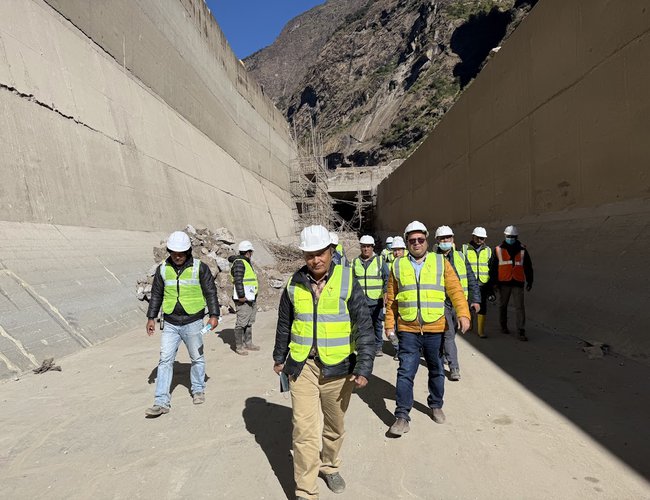
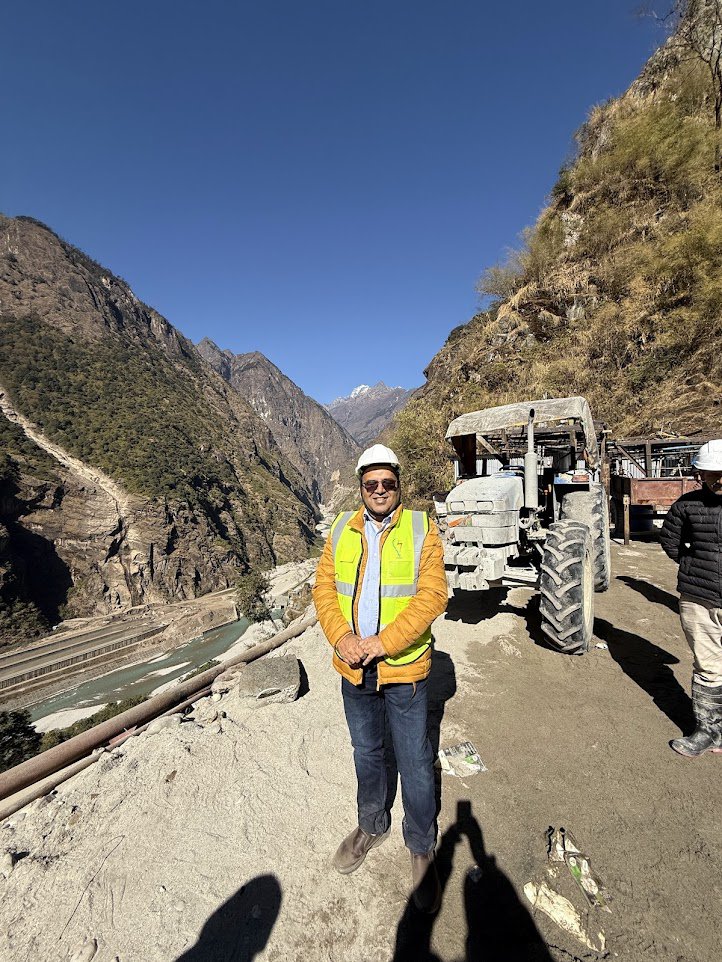
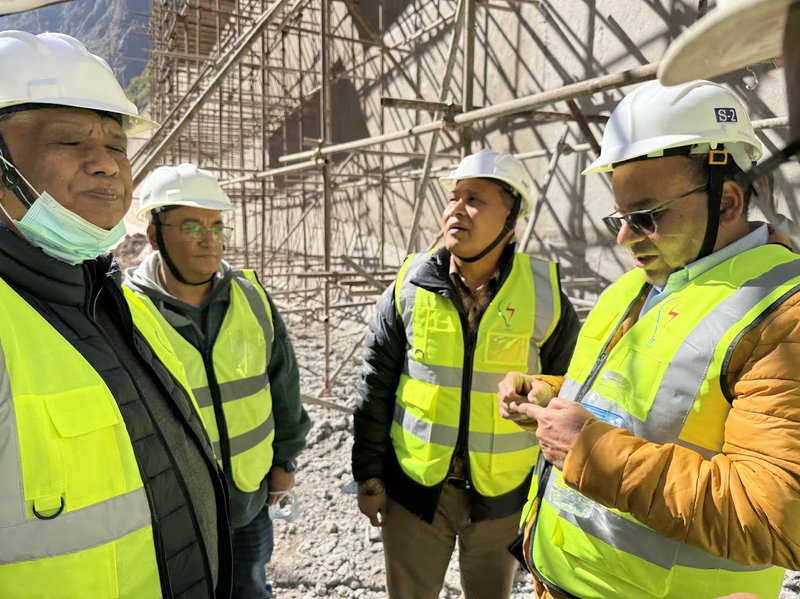
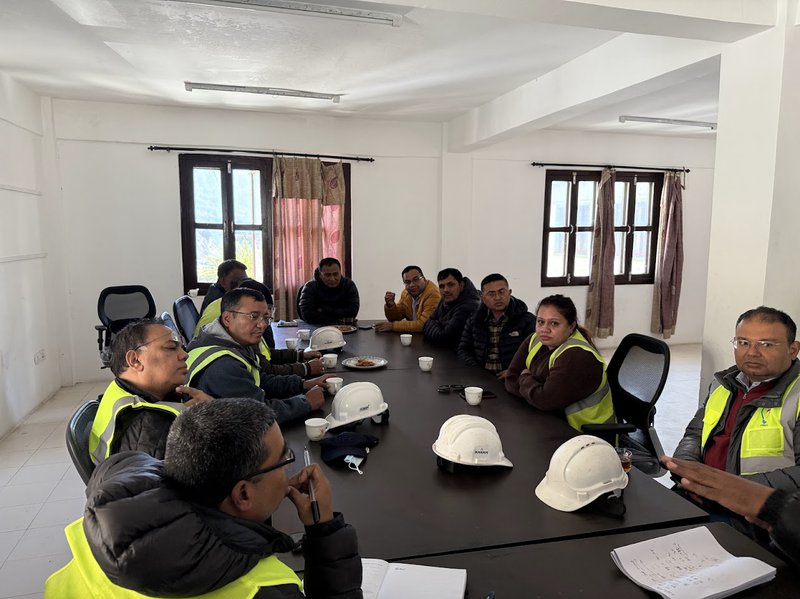
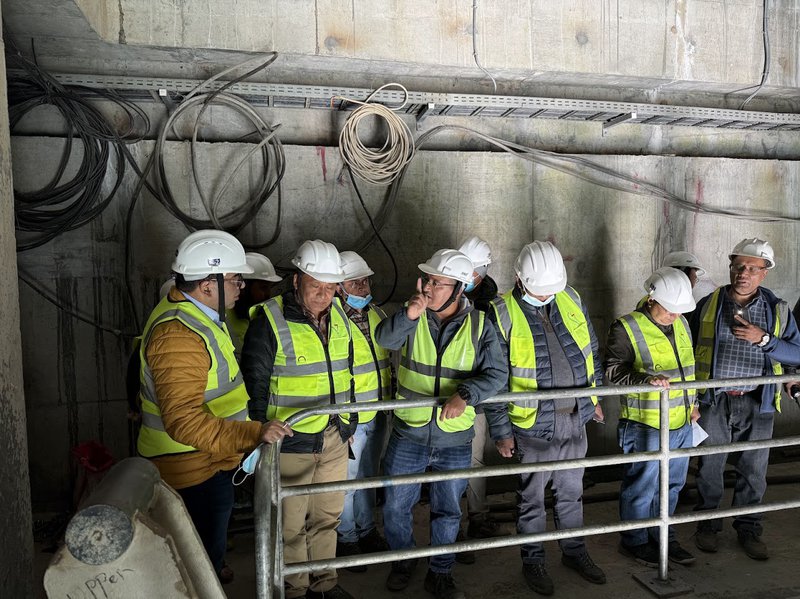
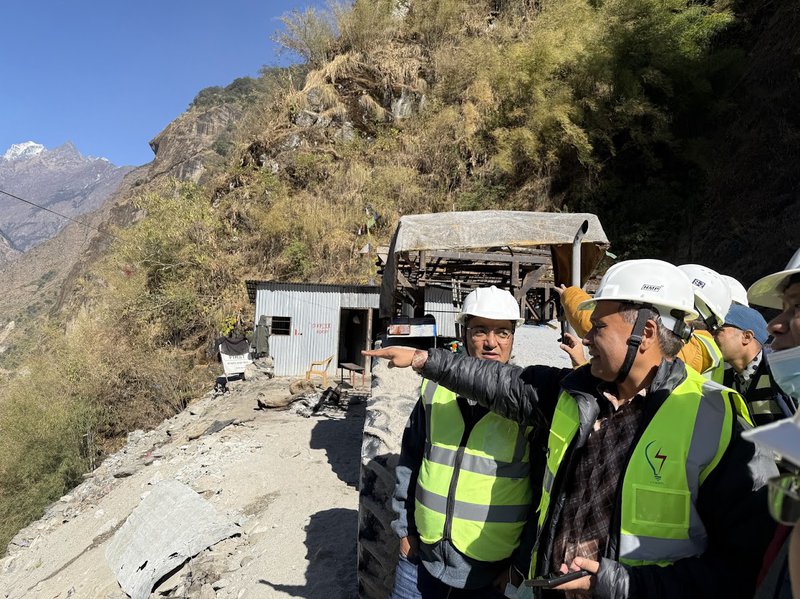
Despite a demanding schedule that included attending an official event for a photo exhibition organized by the Asian Development Bank (ADB) highlighting its 50-year contribution to the energy sector, Kul Man Ghising departed Kathmandu at 3:30 PM on December 3. He was en route to Lamabagar, the dam site of the Upper Tamakoshi Hydropower Project, located 180 kilometers northeast in the remote Dolkha district.
Navigating through challenging terrain marked by rugged roads and numerous deep potholes, MD Ghising arrived in Dolkha, the district headquarters, around 10 PM. He was accompanied by CEO Gautam and Sangita Pahadee, Managing Director of Nepal Telecom, as well as members of the Board of Directors.
MD Ghising's early morning departure was crucial for fulfilling all official obligations, as his visit to the 456 MW Upper Tamakoshi reconstruction site is vital for ensuring a stable power supply during the winter peak and throughout the year.
A delegation from the Nepal Electricity Authority (NEA), led by Managing Director and Chairman of the Board of Upper Tamakoshi Hydropower Limited, Kul Man Ghising, conducted an inspection of the project site on Wednesday. During this visit, they received an update regarding the ongoing maintenance activities at the hydropower facility.

Following discussions with the project management team, consultants, and contractors, the delegation established a timeline aimed at completing the reconstruction and initiating power generation by December 25. The project is designed to operate at full capacity for four hours during peak demand by utilizing water storage during off-peak periods.
The installed capacity of the Integrated National Power system (INPS) is 3,210 MW, with NEA contributing 662 MW through solar and thermal sources, its subsidiaries providing 492 MW, and Independent Power Producers (IPPs) contributing 1,968 MW from hydropower, 82 MW from solar, and 6 MW from Bagas (sugar mill).
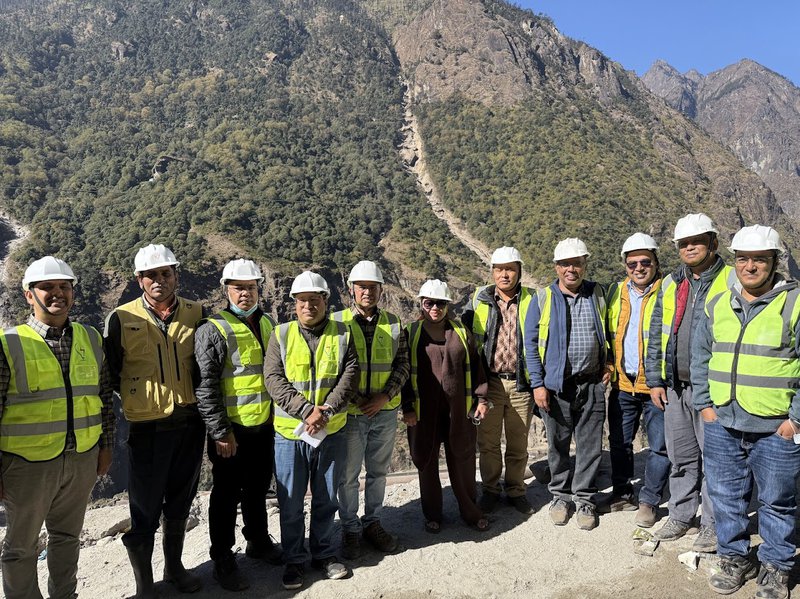
Given that Nepal's peak demand is approximately 1,800 MW, the 456 MW Upper Tamakoshi project is crucial for ensuring a stable power supply during the upcoming winter months. Currently, power generation from run-of-the-river plants operated by IPPs has decreased from 1,500 MW to just over 600 MW, and NEA's own facilities are experiencing similar challenges. Consequently, any delays in the reconstruction of the 456 MW Upper Tamakoshi, which is Nepal's largest hydropower plant, could severely affect the country's power supply and potentially lead to load shedding.
The prompt resumption of power generation from Upper Tamakoshi is critically important, especially considering India's restrictions on exporting power to Nepal during peak winter hours to satisfy its own internal demand.
This situation is of utmost urgency. It is imperative that we complete the reconstruction efforts to ensure the stability of the national power supply. There is no room for hesitation; we must finalize the reconstruction work. If required, we all need to remain on-site for several days to expedite the process, MD Ghising conveyed to the official on the morning of December 4.
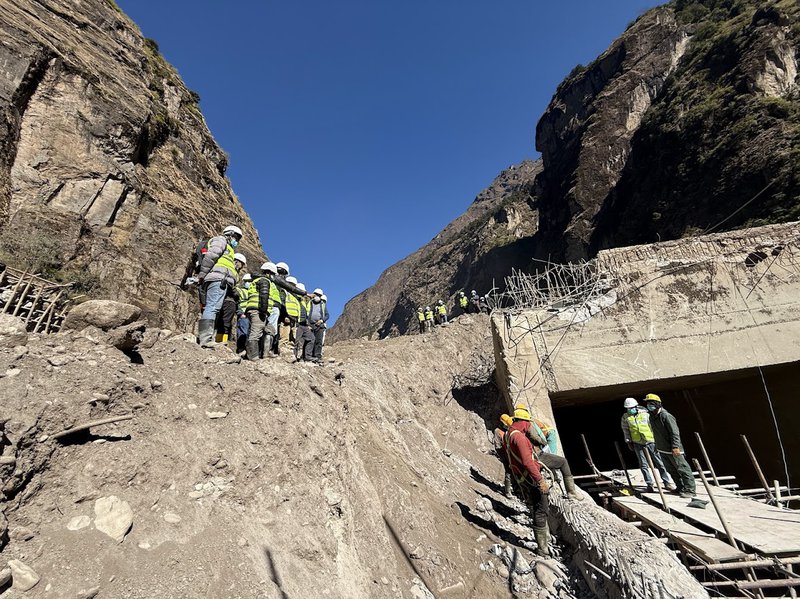
He arrived at the dam site in Lamabagar around 11 am after traversing 60 kilometers of challenging mountain roads from the Dolkha district headquarters. There, he conducted an inspection of the 100 MW Tamakoshi Hydropower V project, which is part of the Upper Tamakoshi cascade project in Gonger.
During his visit, he examined the damaged areas, ongoing construction activities alongside CEO Gautam, other officials, and representatives from the contracting firm. Power generation from the 456 MW Upper Tamakoshi, the largest operational hydropower project, is scheduled to resume by December 25, in accordance with the maintenance plan.
Despite the cold conditions in Lamabagar, the clearance of debris from significant landslides in the sand traps is nearly finished, and efforts to reconstruct the damaged sections of the sand trap wall are currently in progress.
MD. Ghising reviewed the ongoing activities and inquired with field supervisors, engineers, and laborers regarding their requirements for equipment and materials to ensure the timely completion of the work.
After three hours of site inspections across various locations, including the control room area and ongoing structural work, MD Ghising and CEO Gautam of Upper Tamakoshi Hydropower Company Ltd. engaged in two hours of detailed discussions with the consultant NEA Engineering and the contractor High Himal Hydro Construction Pvt. Ltd.
Time is of the essence, and each moment is critical for us. Following the flood and subsequent destruction, we have transitioned from a state of uncertainty to one of clarity. We have identified the areas of damage and the necessary repairs as time progresses. What we require now is sufficient manpower, technical expertise, and material resources," stated MD Ghising. "It is imperative that we establish a formal agreement outlining the work plan and completion timeline. Delays in the reconstruction efforts, whether from the company or otherwise, will adversely impact the nation's economy," he added. "We are now aware of the issues at hand and the corresponding solutions."
In support of MD Ghising's position, CEO Gautam remarked, "Let us document the deadline established in today's meeting and commence work according to the plan. We stand ready to offer any assistance needed by the contractors." He further noted, "The company has been incurring significant revenue losses daily," emphasizing that he has dedicated over 50 percent of his time to the site since the disaster. "To date, we have already suffered a revenue loss of Rs.1.80 billion due to the disaster," CEO Gautam stated. "Moreover, the damage has had repercussions on the national economy. If the work remains unfinished and power is not restored, the consequences will be even more severe."
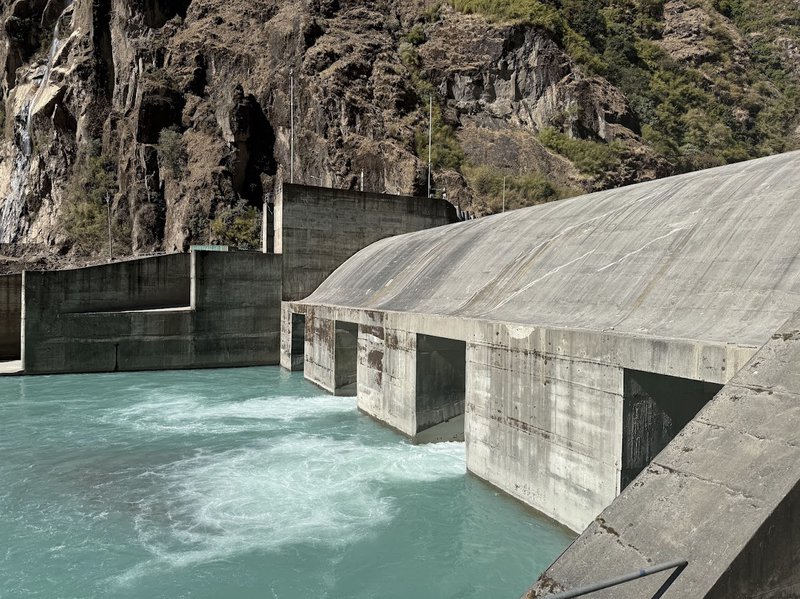
From the contractor's perspective, Taranath Sapkota, First Vice President of High Himalaya Hydro Construction Pvt. Ltd., assured MD Ghising and CEO Gautam of their commitment to adhere to the agreed-upon work plan to expedite the resumption of power generation. "We will mobilize additional equipment and hire more workers to ensure that the reconstruction is completed as scheduled."
Time is of the essence, and each moment is critical for us. Following the flood and its aftermath, we have transitioned from a state of uncertainty to one of clarity. We have identified the areas of damage and the necessary repairs as time progresses. What we require now is sufficient manpower, technical expertise, and material resources, stated MD Ghising. He emphasized the importance of establishing a formal agreement that outlines the work plan and completion timeline. Any delays in the reconstruction efforts, whether from the company or other sources, will adversely impact the nation's economy, he added. "We have a clear understanding of the issues at hand and the solutions needed."
In support of MD Ghising's position, CEO Gautam remarked, "Let us document the deadlines established in today's meeting and commence work according to the outlined plan. We are prepared to offer any necessary assistance to the contractors." He noted that the company is incurring significant revenue losses daily, having dedicated over 50 percent of his time to the site since the disaster. "We have already suffered a revenue loss of Rs.1.80 billion due to the disaster," CEO Gautam stated. "Moreover, the damage has had repercussions on the national economy. If the work is not completed and power is not restored, the consequences will be even more severe."
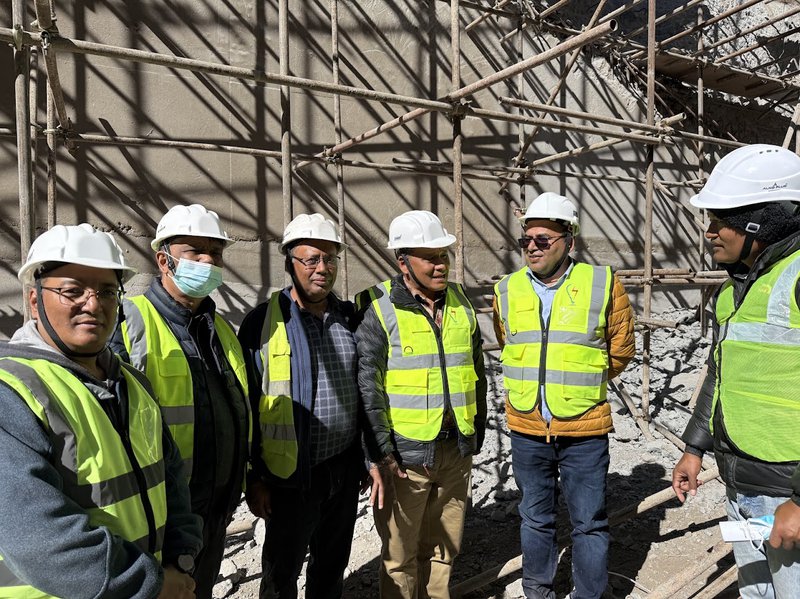
Power generation at the Upper Tamakoshi Hydropower Project, situated in Lamabagar, Bigu Rural Municipality-1, Dolakha, has been halted due to a landslide caused by continuous rainfall on September 27 and 28, which inflicted damage on the dam's headworks. The landslide affected the control room, the sand thickening pond (desander), and the culvert that channels water from the dam to the desander. The Nepal Electricity Authority (NEA) has indicated that repairs to the left-side desander will be completed by December 25, allowing power generation to recommence. The partially damaged slope of the desander wall will be demolished and restored prior to the resumption of power generation. Concurrently, grouting work will address the cracks observed in the walls and ceiling of the culvert, as stated by the NEA. The reconstruction efforts will commence immediately, focusing on the repair of the right-side desander and the design of an underground control room to replace the existing surface structure.
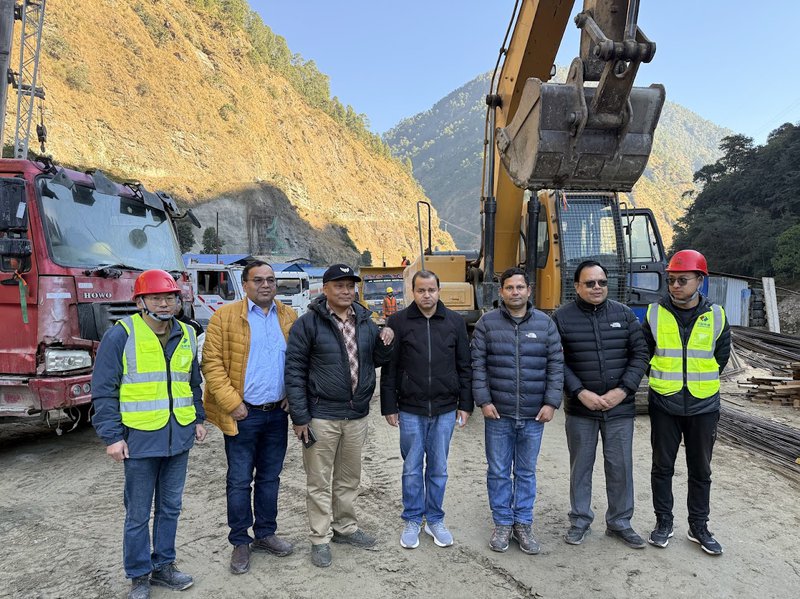
The objective is to finalize this project prior to the onset of the forthcoming rainy season. The repair of one of the towers along the transmission line, which sustained damage due to rainfall, has been successfully accomplished.
Given the anticipated difficulties in meeting internal electricity demands if the plant is non-operational during the winter months, the NEA team has requested an on-site evaluation to identify the necessary actions to ensure the plant is operational at the earliest opportunity.
On December 4, following a night’s rest of approximately nine hours in Charikot, Managing Director Ghising commenced his journey to Gonger and Lamabagar, where the Upper Tamakoshi office and dam site are located. During his visit, he inspected the Tamakoshi V construction site and assessed the ongoing work.
Binod Bhandari, Chief Executive Officer of Tamakoshi Jalvidhyut Company Ltd, along with site engineers from the Chinese firm Sino Hydro Corporation, provided MD Ghising with updates on the project's progress. He emphasized the significance of the project for the nation’s power supply in the near future, noting that the timely completion of the project would significantly bolster Nepal's electricity generation capacity. CEO Bhandari remarked that the advancements made over the past six months have been commendable, stating, "If the necessary explosives are procured, the project will be completed as scheduled."
While MD Ghising was engaged in a demanding schedule visiting reconstruction sites in remote areas of Nepal, Dipak Khadka, the Minister for Energy, Water and Irrigation and Chairman of the NEA, was occupied at the NEA headquarters alongside Secretary Suresh Acharya and an advisor to establish the Chairman's Office.
For the past five months, tensions have arisen between the Prime Minister and Minister Khadka, along with MD Ghising, regarding the collection of revenue from industries utilizing dedicated feeder lines.
On his return journey, Ghising also inspected the construction of the 400 kV New Khimti-Barbise section of the Tamakoshi-Kathmandu 220-400 kV transmission line project, as well as the substation at New Khimti, situated in Sankhe (Fulasi) within Manthali Municipality-13 of Ramechhap.
As the work on the substation approaches completion, the 43 km 400 kV New Khimti-Barbise substation in Sindhupalchok is also nearing its final stages. Out of the 118 towers for the New Khimti-Barbise transmission line section traversing Ramechhap, Dolakha, and Sindhupalchok districts, foundations for over 100 towers have been established, 90 towers have been erected, more than 30 km of wiring has been installed, and efforts are ongoing to finalize the project.
Despite the ongoing disputes and personal criticisms, MD Ghising continues to conduct regular project visits across various regions of Nepal. With nearly 99 percent electricity coverage in the country, it is crucial to avoid any interruptions in the development of new projects and the sustainability of existing ones to ensure a consistent power supply.
In the past month, he has traveled to key regions to oversee the ongoing construction projects and rehabilitation efforts for flood-damaged areas in remote parts of Nepal. During this period, three hydropower initiatives—the Upper Sanjen Hydroelectric Project (14.8 MW), the Sanjen Hydroelectric Project (42.5 MW), and the 111 MW Rasuwagadhi Hydropower Project—were successfully commissioned and integrated into the national grid via the 220 kV Chilime-Trishuli 3B Hub. Additionally, the 102 MW Middle Bhotekoshi Project is nearing the final stages of power generation.
Through his site visits, Managing Director Ghising has played a crucial role in advancing significant transmission line projects, including the 220 kV Chilime
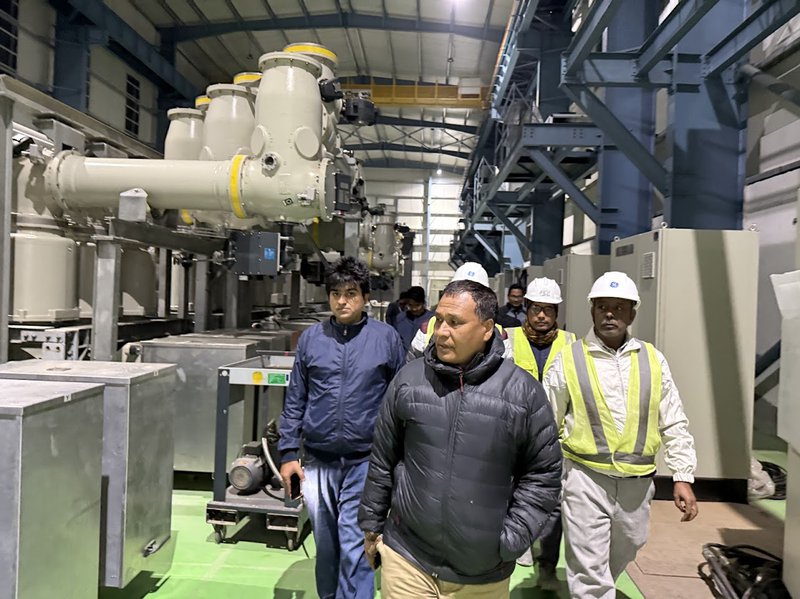
Trishuli 3B transmission line and substation, the 400 kV Inaruwa-Dhalkebar and Dhalkebar-Nijgadh lines, as well as the 200 kV Bardaghat-New Butwal line.
After conducting these inspections and providing guidance, MD Ghising returned home late at night on Thursday, the 5th, traveling along the BP Highway and observing the illuminated villages atop the hills and those nestled below and in the valleys. Despite having spent nearly eight years in his role as managing director, with over 70 percent of his time dedicated to traveling throughout the country, he considers this investment of time to be immensely rewarding, particularly when he witnesses the widespread illumination across the nation.
During his childhood, MD Ghising reminisced about the anticipation surrounding Maghhe Sankrati and Saune Sankrati, when the bright light atop the hill would finally be visible. "The hills would vanish into darkness," he recalled, reflecting on his experiences while overseeing the Upper Tamakoshi hydropower project during his initial term as Managing Director from 2016 to 2020, a period during which he made over 20 visits to the site.
Since its commissioning three and a half years ago, the 456 MW Upper Tamakoshi Hydropower Project, the largest of its kind in Nepal, has been operating effectively, contributing significantly to the nation's energy sector. However, on September 27 and 28, landslides caused damage to the control room, the desander, and the canal that channels water from the dam to the desander, leading to operational challenges and interruptions in power generation. Interestingly, Ghising finds himself in a similar position as the current Managing Director of NEA and Chairman of the company, both of whom share his commitment to resolving these issues. With CEO Gautam as a dependable ally, MD Ghising is well-positioned to tackle the challenges ahead and prevent further power outages.
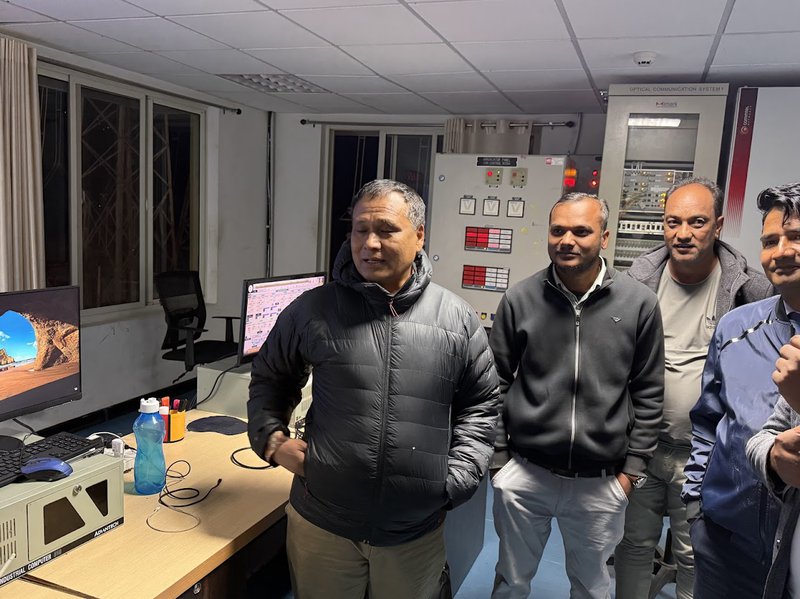
Despite dedicating two full days to intensive work, he maintains a robust physical presence. "I derive immense satisfaction from my work when I witness brighter lights illuminating the villages," MD Ghising stated, gesturing towards a well-lit home perched on the hill along the BP Highway. The successful rehabilitation of the 456 MW Upper Tamakoshi is essential for achieving this vision.

Keshab Poudel
Poudel is the editor of New Spotlight Magazine.
- KUL MAN GHISING: Bowing Down To The People
- Apr 13, 2025
- POLITICAL VIOLENCE: Culture of Impunity
- Apr 11, 2025
- PM OLI MEETS PM MODI: No Progress
- Apr 09, 2025
- PM OLI’S THAILAND VISIT: Flip Flop
- Apr 08, 2025
- FM Dr. Deuba’s India Visit: Mission Aborted
- Mar 26, 2025














